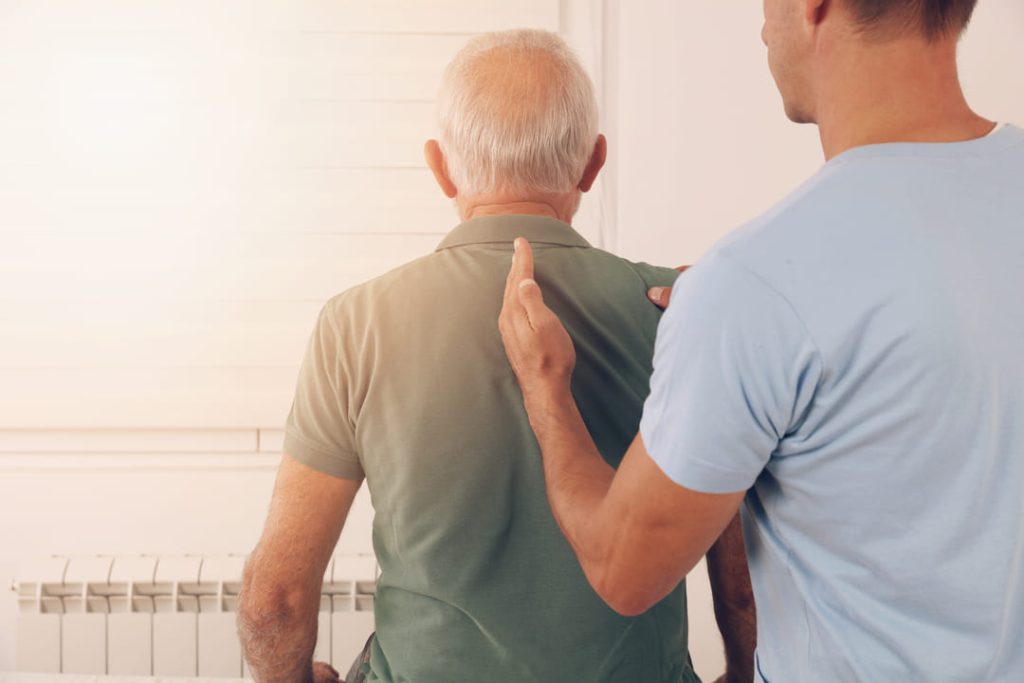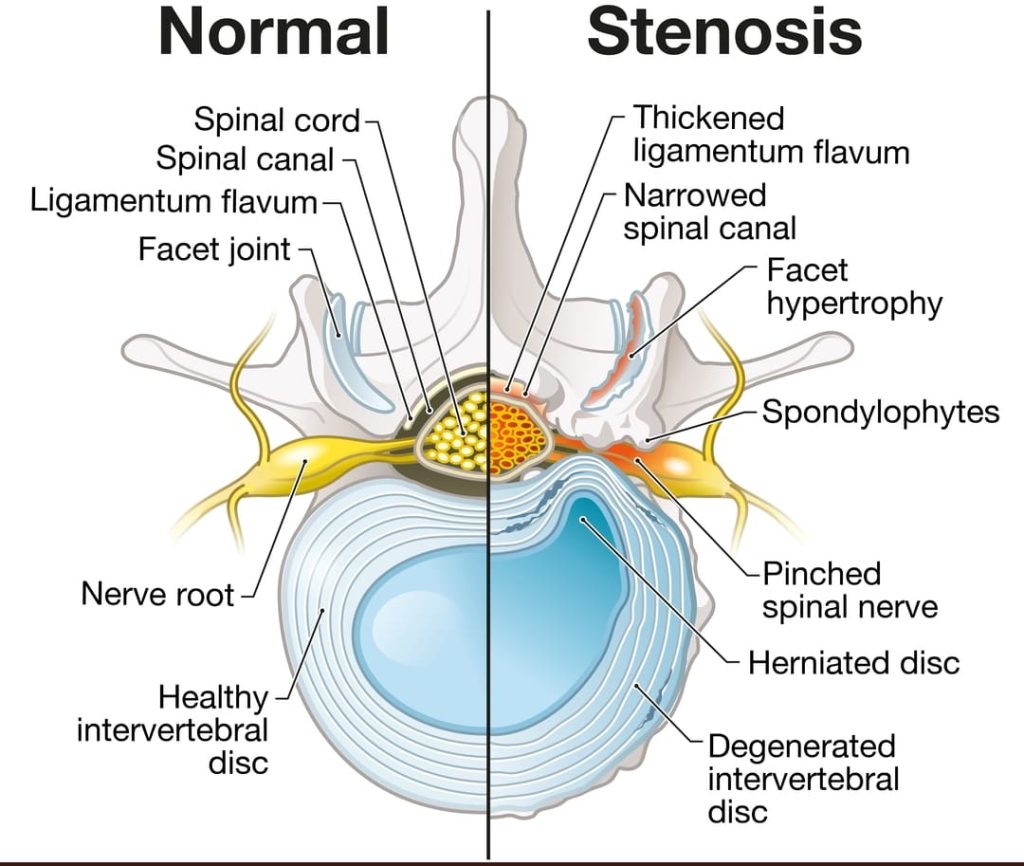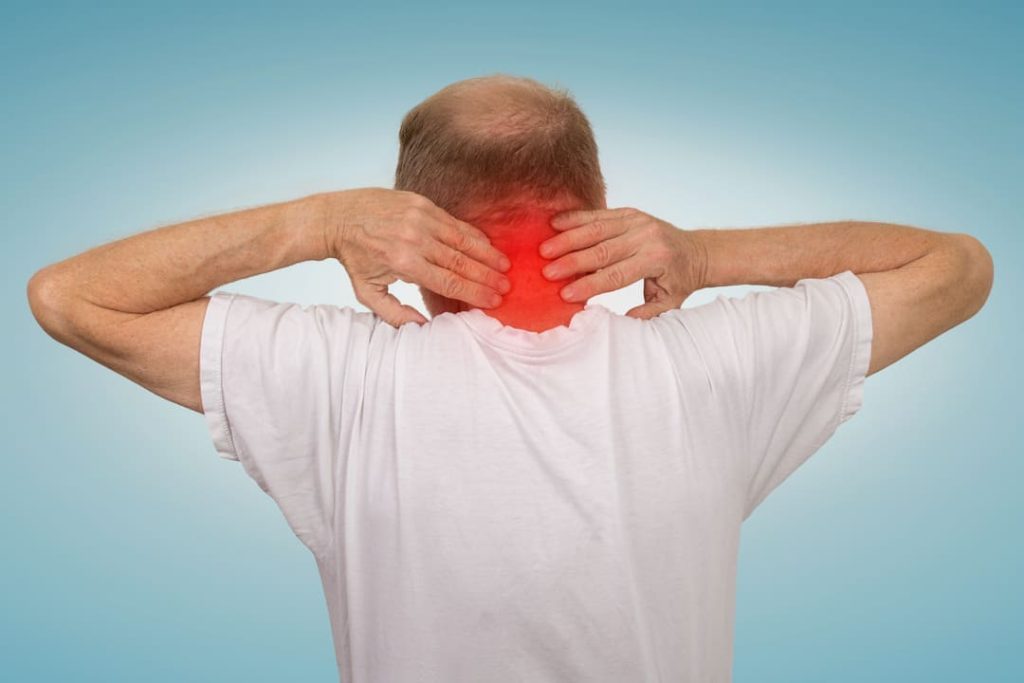Looking for Expert-Level VA Claim Answers?📱Call Us Now! 737-295-2226
In this blog post, we’ll walk you through the criteria you need to meet to earn a spinal stenosis VA rating and some tips to help you win your VA claim.
Spinal stenosis is a condition that can be incredibly painful and debilitating, and it’s one that far too many of our veterans experience. If you’re a veteran with spinal stenosis, you may be entitled to disability benefits through the VA.

You DESERVE a HIGHER VA rating.
Take advantage of a VA Claim Discovery Call with an experienced Team Member. Learn what you’ve been missing so you can FINALLY get the disability rating and compensation you’ve earned for your service.
What is spinal stenosis?
Spinal stenosis is a disabling condition that can severely impact a veteran’s quality of life. The spinal cord is a vital part of the nervous system, and spinal stenosis can cause the spinal cord to become compressed.
Spinal stenosis is when the spinal canal narrows, putting pressure on the spinal cord and nerves. This can lead to pain, numbness, weakness, and difficulty walking. For veterans, this condition can be incredibly debilitating. Your functional capacity may be very limited, as you could be unable to walk, stand, or lift items to live everyday life.
Symptoms of spinal stenosis include:
- Pain in your back or neck
- Cramping in one or both legs
- Numbness, tingling, or weakness in your legs or feet
- Sciatica
- Difficulty walking or standing for long periods
- Loss of balance
- Bladder and bowel issues – including incontinence and feeling like you always have to go
What causes spinal stenosis?
Spinal stenosis can be caused by many things, including degenerative changes in the spine, bone spurs, herniated discs, spinal tumors, or spinal injury. Stenosis often results from wear and tear on the spine with age. However, spinal stenosis can also occur in younger veterans and can be caused by service-related injuries.
Veterans who have sustained spinal injuries during service are at a higher risk for developing spinal stenosis later in life.

In addition, veterans who suffer from other conditions like osteoarthritis or degenerative disc disease are more likely to develop spinal stenosis. Regardless of the cause, spinal stenosis can be debilitating, causing pain, numbness, and weakness in the limbs.
Fortunately, several treatments are available to help ease the symptoms of spinal stenosis and improve your quality of life.
1. How can I get my spinal stenosis service connected?
To get VA disability for spinal stenosis, the VA must service connect your condition. You’ll need to show that your spinal stenosis was caused by or aggravated by your time in service.
To be eligible for a spinal stenosis VA rating, you must meet three criteria by law:
- You have a medical diagnosis for spinal stenosis, and you’re experiencing current symptoms
- You experienced an event, injury, or illness while you were serving that caused or aggravated your spinal stenosis (either directly or indirectly)
- There’s a nexus (or a link) between your spinal stenosis and your military service
You can do this with medical records, lay evidence (testimony from friends or family members), or a nexus letter from a doctor linking your service-connected condition to an event or injury during your time in service.
There are several different ways to establish service connection for spinal stenosis:
- Direct Service Connection – This is when there is a clear link between your spinal stenosis and your military service. An example would be if you had a back injury or other trauma while serving that led to spinal stenosis.
- Secondary service connection – If another injury or illness caused by service connection eventually leads to your spinal stenosis. One example is if you’re already service-connected for a herniated disk.
The VA’s burden of proof for service connection is that your spinal stenosis is “at least as likely as not” caused or worsened by your military service. The strongest nexus letters include a nexus statement with the words “at least as likely as not,” assuming the independent medical provider believes your spinal stenosis was caused or worsened by your active duty military service.
You’ll also be required to provide the VA with medical imaging tests to show that you have spinal stenosis and its severity. This could be in the form of MRIs, or CT scans taken by your private doctor or from military or VA medical records.
Spinal stenosis is usually very apparent in these images, and these images are compelling evidence.

2. What is the spinal stenosis VA rating?
The VA can assign separate ratings if your condition impacts your lumbar and cervical spine.
Your lumbar spine is your lower back and consists of five vertebrae. Your cervical spine goes from the base of your skull or your neck down to your shoulders and consists of seven vertebrae.
If you meet all the criteria listed above for service connection for spinal stenosis, you’ll be given a spinal stenosis VA rating under Diagnostic Code 5238. Spinal stenosis is usually rated using the general rating formula for diseases and injuries of the spine. However, it’s worth mentioning that there is another way the VA could rate you if there is little evidence of spinal stenosis in your medical records.
First, let’s cover how a VA disability rating for spinal stenosis works for most veterans.
The spinal stenosis VA rating formula gives you a range of motion (ROM) percentage based on which spinal region is affected by your condition. Depending on how severely your spinal stenosis impacts your ability to function, you can earn a rating anywhere from 10% to 100%.
100% Spinal Stenosis VA Rating
To be granted a VA disability rating for spinal stenosis at 100%, you must have unfavorable ankylosis of the entire spine and additional symptoms. Unfavorable ankylosis means that you cannot move your spine in any direction, and your spine is frozen in an unfavorable position.
To be considered for a 100% rating, you must have a “frozen” spine along with at least one of these symptoms:
- Vision impairment that makes it difficult to walk
- Restricted opening of the mouth can make it difficult to chew food.
- Breathing is limited to diaphragmatic respiration or abdominal breathing
- Gastrointestinal symptoms can be caused by pressure on the abdomen from the bottom edge of your rib cage
- Shortness of breath
- Difficulty swallowing
- Vertebrae slippage with a high likelihood of damage to the spinal cord
- Misalignment or dislocation of the 1st and 2nd vertebrae in your neck
- Other neurological symptoms caused by nerve root stretching
50% Spinal Stenosis VA Rating
To be granted a VA disability rating for spinal stenosis at 50%, you must have virtually no range of motion, with your mid and upper back frozen in an unfavorable position. You have unfavorable ankylosis of the entire thoracolumbar spine. This portion of your spine is made up of 29 vertebrae and includes the vertebrae from your neck all the way down to your sacrum.
40% Spinal Stenosis VA Rating
At this rating, the VA begins to assign cervical spinal stenosis VA disability ratings. In order to be granted a VA disability rating for spinal stenosis at 40%, you must meet one of these conditions:
- Unfavorable ankylosis of the entire cervical spine (your cervical spine goes from the base of your skull or your neck down to your shoulders and is made up of 7 vertebrae)
- Forward flexion of the thoracolumbar spine 30 degrees or less, or
- Favorable ankylosis of the entire thoracolumbar spine, where your spine is fixed in place, but at a neutral position at 0 degrees.
30% Spinal Stenosis VA Rating
In order to be granted a VA disability rating for spinal stenosis at 30%, you must meet either of these conditions:
- Unfavorable ankylosis of the entire cervical spine, or
- Favorable ankylosis of the entire cervical spine, where your spine is fixed in place but at a neutral position at 0 degrees.
20% Spinal Stenosis VA Rating
In order to be granted a VA disability rating for spinal stenosis at 20%, you must meet one of these conditions:
- The thoracolumbar spine (the part of the spine between your chest and your lower back) can bend more than 30 degrees but not more than 60 degrees
- The cervical spine (the part of your spine in your neck) can bend forward more than 15 degrees but not more than 30 degrees
- The combined range of motion of the thoracolumbar spine is not greater than 120 degrees
- The combined range of motion of the cervical spine is not greater than 170 degrees, or
- Muscle spasms or guarding cause an abnormal gait or spinal contour. This might mean that your spine is curved in a way that is not normal or that your back is very stiff and you have scoliosis, reversed lordosis, or abnormal kyphosis
10% Spinal Stenosis VA Rating
In order to be granted a VA disability rating for spinal stenosis at 10%, you must meet one of these conditions:
- The thoracolumbar spine (the part of the spine between your chest and your lower back) can bend more than 60 degrees but not more than 85 degrees
- The cervical spine (the part of your spine in your neck) can bend forward more than 30 degrees but not more than 40 degrees
- The combined range of motion of the thoracolumbar spine is greater than 120 degrees but not greater than 235 degrees
- The combined range of motion of the cervical spine is greater than 170 degrees but not greater than 335 degrees, or
- Muscle spasm, guarding, or localized tenderness not resulting in abnormal gait or abnormal spinal contour; or vertebral body fracture with loss of 50 percent or more of the height
Alternative Method to Rate Spinal Stenosis
You may not be showing severe symptoms of spinal stenosis. Still, you may be experiencing a great deal of pain or spinal instability. In this case, the VA could rate you under Diagnostic Code 5243 if you’re experiencing intervertebral disc disease syndrome. You could be eligible for a higher VA rating under this diagnostic code, under the rating criteria for incapacitating episodes.
An incapacitating episode is when a veteran is prescribed bed rest by their doctor. The VA rates incapacitating episodes from 10% to 60%:
- 60% – You’ve experienced at least six weeks of incapacitating episodes in the past year.
- 40% – You’ve experienced at least four weeks of incapacitating episodes in the past year.
- 20% – You’ve experienced at least two weeks of incapacitating episodes in the past year.
- 10% – You’ve experienced at least one week of incapacitating episodes in the past year.

3. The Compensation & Pension (C&P) Exam for Spinal Stenosis
You can expect a few things if you have a Compensation and Pension (C&P) exam for your spinal stenosis VA rating. During this exam, the physician will most likely ask you questions to determine how far you can move your spine and what portions of your spine you cannot move. The doctor will be considering which rating method to use during your evaluation.
VA disability ratings for spinal stenosis require an accurate range of motion test of the flexion of different sections of your spine. A goniometer should be used at your C&P exam to measure your spine’s range of motion; each measurement is rounded to the nearest five degrees.
Make sure you don’t push through the pain for these range of motion tests. If you feel any discomfort during the test, stop. Many veterans tend to downplay symptoms. You must be truthful with your evaluator during your C&P exam to get the rating you deserve.
Read the C&P Examiner’s Guide for spinal stenosis here.
Our expert VA coaches can assist you if you need help filing a claim for spinal stenosis. We’ve helped thousands of veterans like you file successful claims, and we’re here for you. Contact us today to learn more about how we can help you get the benefits you deserve. Thank you for your service!

NEED MORE ASSISTANCE?
Most veterans are underrated for their disabilities and therefore not getting the compensation they’re due. At VA Claims Insider, we help you understand and take control of the claims process, so you can get the rating and compensation you’re owed by law. Our process takes the guesswork out of filing a VA disability claim and supports you every step of the way in building a fully-developed claim (FDC)—so you can increase your rating FAST!
If you’ve filed your VA disability claim and have been denied or have received a low rating—or you’re unsure how to get started—reach out to us! Take advantage of a FREE VA Claim Discovery Call. Learn what you’ve been missing—so you can FINALLY get the disability rating and compensation YOU DESERVE!




